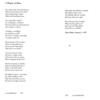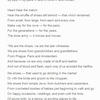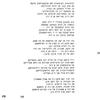4: Poetry by Holocaust survivor-poets Abraham Sutzkever and Moses Schulstein, in Yiddish and English translation.
Yiddish poets and Holocaust survivors, Abraham Sutzkever and Moses Schulstein, both wrote poems that describe trauma and memory through the central image of shoes. Written in the Vilna Ghetto on January 1, 1943, Sutzkever’s “A Wagon of Shoes” depicts shoes that are simultaneously empty and imbued with memory. The shoes move and pulse, and are strikingly incomplete. In Moses Schulstein’s “I Saw a Mountain,” a pile of shoes animates and shares its testimony. In both poems, shoes are no longer able to serve as support for walking, but they emotionally transport writer and reader.
Suggested Activity: In small groups, have students read aloud and study either Sutzkever or Schulstein’s poem. For Sutzkever’s, ask students what the use of questions tell us about the narrator and the mood that he creates. Ask students why he tracks the movement from Vilna (often referred to as the “Jerusalem of Lithuania”) to Berlin. How might one see his poem, written in the Vilna Ghetto, as a form of resistance? For students with a background in Yiddish, have them listen to Sutzkever’s poem the Smithsonian Folkways Recording and compare it to the English translation.
In Schulstein’s poem, the mountain of shoes is more “Holy than the Mountain of Sinai.” Ask students to interpret this line. What connections can we draw between the mountain of Sinai and the mountain of shoes? If God’s law is the gift that was received at Mount Sinai, what is the gift that is received at Mount Shoes? Is God present on this mountain? What gives the shoes or this moment its “holiness”? What is “holier” than God’s law? Is this a call to a new type of covenant?
Then have the class come together and ask the groups to report to each other what they’ve discovered about each poem. Have students compare the poems’ uses of shoe imagery to the anthropomorphized shoes in Keret’s story. Ask students to list the ways in which shoes are used as symbols or metonyms in all three texts. Then ask: what does it mean to “bear witness” to the Holocaust? Can objects (such as shoes) bear witness? If so, how?
Sources: Abraham Sutzkever, “A Wagon of Shoes,” trans. Barbara and Benjamin Harshav, A. Sutzkever: Selected Poetry and Prose (Berkeley: University of California Press, 1991), 151.
Abraham Sutzkever, Di fesṭung lider un poemes : geshribn in Ṿilner Geṭo un in ṿald 1941-1944 (New York: Yiddisher Kultur Farband, 1945), 27-8.
Abraham Sutzkever, “Sutzkever Recites 13 Poems," The Frances Brandt Online Yiddish Audio Library.
Moses Schulstein, “I Saw a Mountain,” trans. Beatrice Stadtler and Mindele Wajsman, in From Holocaust to New Life: A Documentary Volume Depicting the Proceedings and Events of the American Gathering of Jewish Holocaust Survivors, ed. Michael Berenbaum (American Gathering of Jewish Holocaust Survivors, 1985), 121. http://www.70voices.org.uk/content/day36.
Moses Schulstein, A boym tsṿishn ḥurṿes̀ lider un poemes. (Paris: Editions Ofsnai, 1947), 170-2.
Sutzkever_poem_-_English.jpg
 Download image (211.78 KB)
Download image (211.78 KB) Sutzkever_poem_-_Yiddish.jpg
 Download image (423.5 KB)
Download image (423.5 KB) Schulstein_poem_English.jpg
 Download image (438.43 KB)
Download image (438.43 KB) Schulstein_poem_Yiddish.jpg
 Download image (384.59 KB)
Download image (384.59 KB)




